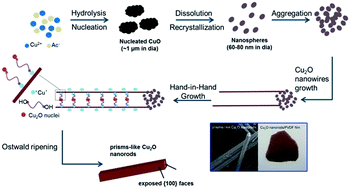EG-Assisted hand-in-hand growth of prism-like Cu2O nanorods with high aspect ratios and their thermal conductive performance†
Abstract
In this work, one-dimensional, monodispersed prism-like Cu2O nanorods with a significantly high aspect ratio (∼100) have been successfully prepared by a simple hydrothermal synthesis with the assistance of ethylene glycol (EG). The obtained nanorods expose {100} faces and have a rectangular cross section. Their length, thickness and width are in the range of 50–100 μm, 0.5–1 μm and 0.5–1.5 μm, respectively. Pyrrole (Py) and EG play important roles in the formation of the prism-like nanorods. Py acts as a structure-directing reagent that makes the Cu2O crystal grow along the [100] direction. EG acts as a “bridge” that controls the “hand-in-hand” growth of the intermediate Cu2O nanowires and transforms them into prism-like nanorods. The products are first employed as thermal conductive nanofillers to improve the thermal conductivity of poly(vinylidene fluoride) (PVDF)-based polymer composites. The original thermal conductivity studies indicate that the rod-type structural nanomaterials are very efficient fillers for polymer composites. When they were embedded in the PVDF matrix at 30 wt%, the Cu2O nanorods show a thermal conductivity enhancement (TCE) of 275% when compared with the pristine PVDF, which is 1.4 times higher than commercial Cu2O (cubes) used as fillers in PVDF composites.


 Please wait while we load your content...
Please wait while we load your content...